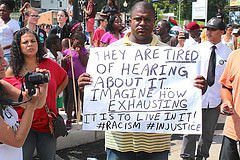
The first Native American says to the second Native American, “Go get the calculator.”
I was a teenager when I read this cartoon, but I still have a pretty vivid memory of it. I remember that when my mother (who used her $20,000 check to help pay for my college education) saw it, she gave a short laugh and said something like, “Yes, Native Americans should be getting reparations too. And more than us.”
This cartoon has popped back into my head over the past few weeks because Ferguson has been on my mind, still.
Ferguson doesn’t seem to be going away anytime soon. Nor should it. It is a touchstone moment in a time when so many had come to believe that we had moved beyond race. Ferguson explodes the mythology that we live in a post-racial country. Ferguson shows that there are still deep divides along racial lines in terms of how people are treated and in how people perceive the meaning of a black youth being shot and killed by a white policeman.
And it’s not just that Ferguson is a bright, burning reminder of the importance of race, it more specifically reminds us about the durability and intensity of violent racism against African Americans.
As an Asian American who often talks and writes about how racism affects Asian Americans, I always try to think/write/act in a frame that is in the spirit of my mother’s reaction to the editorial cartoon—our own complaints are legitimate, the remedies that we have received and still seek are appropriate, but other communities also suffer, also deserve restitution. We all must advocate for and work towards a bigger justice. This is one reason why the memory of the editorial cartoon is in my head.
A second reason why I’m thinking about the cartoon is that Ferguson has reawakened in me the belief that African Americans should receive reparations. I don’t know if reparations should be calculated as the present value of forty acres and a mule, should justified because of slavery or Jim Crow or just plain old ongoing racism. I don’t know even know if reparations are the answer, per se. I don’t even know if it’s my place to say. But I believe that something needs to be done on the scale of reparations, something that acknowledges the depth of the wrong committed, the depth of the racial divide that still persists. And whatever is done can ever only be a gesture, a token that can never make up for our history. But Ferguson says that we can’t heal until there is a more public, more comprehensive, more serious, more generous gesture.
Not that we should only throw money at problems and not that we can adequately monetize pain and oppression, but the gesture needs to cost. Because we are living in a material world, where social and economic meaning are so deeply intertwined, the only way we can know if the gesture is serious and sincere is if it comes with a big price tag.
OUR COLLECTIVE BENEFIT, OUR COLLECTIVE DEBT
One of the arguments I’ve heard/seen most often against restitution for African Americans is that it is unfair for current generations to pay for the sins of past Americans. I’ve heard a variant of this maybe most often from ethnic, non-WASP whites but also from Asian Americans, Latinos, other immigrants and the progeny of immigrants more broadly: “Our ancestors weren’t even in this country when slavery existed. Our ancestors never owned slaves. They came here poor, faced discrimination, had to work their way up. Why should we have to pay for something our ancestors/we never did?”
But all of us inherit the history of this country, good and bad. We all are responsible for its debts. And even for those of us who are not part of the one percent, most of us benefit in some way from the power and economic standing of this country—wealth and strength that were ill-gotten, that were purchased with stolen labor (and stolen land).
This is where the cartoon and my mother’s reaction come back in. We can assert the legitimacy of each of our own communities’ struggles but we can and must also assert the centrality of African Americans’ history and role in building this country. Talking about the historic debt due to African Americans (and women and Native Americans, if we’re talking about the early history/formation of this country) is something that falls upon all of us to do—making this case should not solely be the responsibility of African Americans.
As Asian Americans in general and as Japanese Americans in particular, I believe we can play an important role in pushing for reparations, in pushing for racial healing. As a community that is made up of immigrants and the descendants of immigrants, as a community that has fought for and received reparations, as a community that is so often used as a wedge in divide and conquer politics, we have a special responsibility to lend our voice, our efforts, our legitimacy to this struggle.
Again, I don’t know if reparations are the solution. I don’t know if reparations are appropriate or even realistic. It’s just something that’s been in my head as I think more about Ferguson. Ferguson shows us that we have not escaped our past, we are not post-racial, and that we need a deeper reckoning before we can move forward. And even if reparations are not the specific vehicle, I believe we need something of a similar scope and scale to reparations. Like the first Indian Native American says to the second Native American in the cartoon, it’s time to get the calculator.
Photo by Flickr user BobboSphere CC BY





Comments